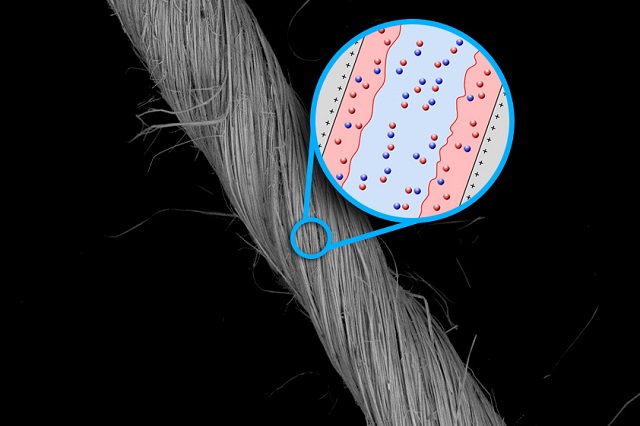 Yarn made of niobium nanowires, seen here in a scanning electron microscope image (background), can be used to make very efficient supercapacitors, MIT researchers have found. Adding a coating of a conductive polymer to the yarn (shown in pink, inset) further increases the capacitor's charge capacity. Positive and negative ions in the material are depicted as blue and red spheres. Courtesy of the researchers
Yarn made of niobium nanowires, seen here in a scanning electron microscope image (background), can be used to make very efficient supercapacitors, MIT researchers have found. Adding a coating of a conductive polymer to the yarn (shown in pink, inset) further increases the capacitor's charge capacity. Positive and negative ions in the material are depicted as blue and red spheres. Courtesy of the researchers
A team of researchers from MIT and University of British Columbia has discovered an innovative method to deliver short bursts of high power required by wearable electronic devices.
Such devices are used for monitoring health and fitness and as such are rapidly growing in the consumer electronics industry. However, a major drawback of these devices is that they are integrated with small batteries, which fail to deliver sufficient amount of power required for data transmission.
According to the research team, one way to resolve this issue is to develop supercapacitors, which are capable of storing and releasing short bursts of electrical power required to transmit data from smartphones, computers, heart-rate monitors, and other wearable devices. supercapacitors can also prove useful for other applications where short bursts of high power is required, for instance autonomous microrobots.
Supercapacitors are pairs of electrically conducting fibers that have an insulator in between. In the latest method, yarns of niobium nanowire are used as electrodes in compact supercapacitors. Ian W. Hunter, MIT professor of mechanical engineering, Seyed M. Mirvakili, PhD student and three others from the University of British Columbia have reported the study results in the journal, ACS Applied Materials and Interfaces.
Over the past few years, nanotechnology experts have been working to boost the performance of supercapacitors. Although carbon-based nanoparticles like graphene and carbon nanotubes are potential candidates, they are characterized by low electrical conductivity. In the latest study, the researchers have demonstrated that preferred properties such as high power density are not restricted to carbon-based nanoparticles, and that yarn made from niobium nanowires offers a potential option.
Imagine you’ve got some kind of wearable health-monitoring system, and it needs to broadcast data, for example using Wi-Fi, over a long distance, said Hunter, the George N. Hatsopoulos Professor in Thermodynamics at the Department of Mechanical Engineering, MIT. Long-distance Wi-Fi requires a fair amount of power, but it may not be needed for very long.Small batteries are generally poorly suited for such power needs.
Ian W. Hunter, MIT professor of mechanical engineering
At present, many small electronic devices have coin-sized batteries that do not deliver a large amount of power immediately, which is integral to transmit data.
We know it’s a problem experienced by a number of companies in the health-monitoring or exercise-monitoring space. So an alternative is to go to a combination of a battery and a capacitor. The battery for long-term, low-power functions, and the capacitor for short bursts of high power. Such a combination should be able to either increase the range of the device, or — perhaps more important in the marketplace — to significantly reduce size requirements.
Ian W. Hunter, MIT professor of mechanical engineering
The novel nanowire-based supercapacitor not only surpasses the performance of present-day batteries, but also takes up a small volume.
If you’ve got an Apple Watch and I shave 30 percent off the mass, you may not even notice, but if you reduce the volume by 30 percent, that would be a big deal. Consumers are very sensitive to the size of wearable devices, Hunter said.
Hunter further added that this latest breakthrough holds importance for compact devices because batteries, fuel cells, flywheels and other energy-storage technologies are not highly efficient or they are too complicated to prove useful when reduced to compact sizes. In contrast, the new technology can deliver large bursts of power from a compact device.
According to Hunter, it would be useful to have a high volumetric energy density and high volumetric power density. To date, nobody has found out how to do that, but with the latest device, a combination of medium energy density, high volumetric power density and low cost was achieved, thus making it suitable for a wide range of applications.
Mirvakili informed that niobium material is extensively used and is quite abundant. As a result, the entire system can be produced easily in a cost-effective way. Other researchers used carbon nanotubes and other materials to make similar supercapacitors; however, the niobium yarns are much more conductive and stronger. On the whole, supercapacitors based on niobium materials have the ability to store as much as five times more power in a specified volume as carbon nanotube versions. Also, niobium has a high melting point which is almost 2,5000C. It is also highly flexible and can be integrated into fabrics to allow wearable forms. Devices based on these nanowires can also be used in high-temperature applications. Individual niobium nanowires have a diameter of just 140nm, which is one-thousandth the thickness of a human hair. Till date, niobium has been synthesized in lab-scale instruments. The next step would be to design a practical version that can be produced easily, and is already in progress.
The work is very significant in the development of smart fabrics and future wearable technologies. This paper convincingly demonstrates the impressive performance of niobium-based fiber supercapacitors.
Geoff Spinks, a professor of engineering at the University of Wollongong
Professors John Madden and Peter Englezos, and doctorate student Mehr Negar Mirvakili from the University of British Columbia also contributed to the study.
References